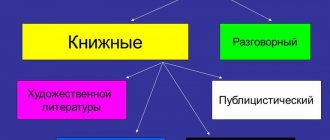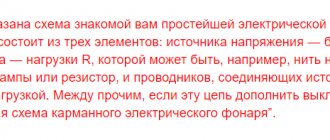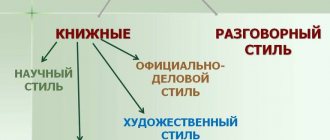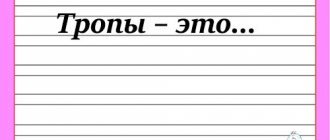4.6
Average rating: 4.6
Total ratings received: 765.
4.6
Average rating: 4.6
Total ratings received: 765.
The branch of the science of language, called stylistics, studies functional styles of speech. What it is and how they differ, we will tell you in this article.
The material was prepared jointly with the highest category teacher Lyubov Alexandrovna Koroshchup.
Experience as a teacher of Russian language and literature - 30 years.
What styles are there?
Depending on the communicative task, when creating texts, we use one or another style. It is he who determines what lexical and syntactic means we need.
Because the choice of style depends on the function that the text is intended to perform, styles are called functional. Usually in the modern Russian language the following types of functional speech styles are distinguished: scientific, official business, colloquial, journalistic and the style of fiction (fiction).
Not all scientists believe that it is right to distinguish an artistic style, because it combines the features of all styles.
Definition and characteristics
Speech styles are varieties of literary language, distinguished in accordance with the role (function) they perform in communication. They are used in various spheres of public life - everyday conversations, scientific works, fiction, journalistic addresses, and so on.
Each of the functional styles of the Russian language consists of both neutral and specific expressive means . Their features depend on the following factors:
- sphere of communication - everyday, political, professional, social and others;
- the goal is to briefly and succinctly convey information, awaken certain emotions, call to action and motivation, establish contact, and so on;
- method - contact, non-contact, mass, personal.
Differences in styles appear at all levels - from intonation and stress placement to the nature of grammatical and syntactic structures, spelling, and vocabulary. In practice, they often mix and interact, especially in oral communication. Incorrect use of stylistic features can create ambiguity or misinterpretation of speech, which is why it is important to avoid this. Substyles are also distinguished. They are used in specific areas of texts, mainly scientific ones.
Styles are used in different genres. They mean types of texts - from a fiction novel or poem to a scientific report, article, official order, interview. Each of them must meet certain requirements for the means of expression and the method of their organization.
Scientific style
Scientific style is sometimes called “encyclopedia style.” Typical genres for it are:
- Research Article;
- monograph;
- thesis;
- popular science article;
- lecture, etc.
This style is characterized by the use of terms, accuracy, and adherence to a certain structure of reasoning. Texts in this style contain specific facts, figures, quotes, and links to other scientific works.
Like other styles, scientific has a number of substyles, which have different main features. Thus, popular science text is characterized by greater freedom and entertainment, and fewer terms. The recipients of texts in a scientific style are scientists, students, schoolchildren, people interested in science. The goal is the transmission of accurate scientific facts and training.
Main features and characteristics of the scientific style of speech
The features and characteristics of the scientific style include:
- Logical presentation - information is presented consistently and in a clear sequence.
- Generality, accuracy and objectivity in the presentation of information.
- Evidentiary and rich presentation (many arguments, facts).
- Application of terms and general scientific words. On average, terms occupy about 15-20% of the total text volume.
- The use of words with an abstract meaning (these are words that do not evoke specific images in the mind and memory, for example: property, essence, worldview, reality).
- Most often there is a monologue character of speech.
- More nouns and adjectives, and a minimum of verbs.
- Complex sentence construction.
- The sentences are mostly long.
- Practically no means of expression are used (epithets, comparisons, metaphors, etc.) and there is no expressive-emotional vocabulary (admirable, son, inspire, despise, sycophant).
- Correct word order.
- Strict sequence of presentation.
Formal business style
This is the “document style”. It is characterized by extreme unification of linguistic means, a large number of language clichés (standard formulas), and special vocabulary - clericalism.
In an official business style, clericalisms are appropriate as specific vocabulary (a kind of term); but no other style uses them.
The addressee of the text in this style is an official, a clerk. The goal is to convey official factual information in a condensed form. Genres : statement, memo, report, etc.
Official or business
The official style of speech is used in managerial, administrative, legal and diplomatic spheres of human activity. It is used in documents and contracts, legislative regulations, business and some specific genres of literature, such as autobiography. There are 5 main substyles:
- legislative;
- business correspondence;
- clerical;
- diplomatic.
The style differs from others in that its features and rules of application are enshrined in official manuals and GOSTs for the purpose of standardization and unification. Therefore, it develops slowly and is little subject to change, regardless of time, location, cultural and other characteristics of the population. Distinctive features of the style:
- standardization;
- language that leaves no room for ambiguity or misinterpretation;
- conciseness;
- a combination of neutral, bookish and special vocabulary, the use of professional terminology;
- use of official speech stamps;
- the presence of archaisms (outdated words), absence of slang and neologisms;
- unambiguity of information, confirmed by references to its sources (articles in codes, clauses of the contract, and so on);
- abundance of verbal nouns (application, confirmation) used to reduce volume;
- direct word order;
- sentences with complex grammatical construction, use of participial and participial phrases;
- a large number of enumerations, homogeneous members of the sentence;
- use of passive designs (accepts board instead of accepts board);
- speech without any expressiveness, emotional or figurative coloring;
- narrative nature of the presentation;
- abundance of details and clarifications.
In colloquial speech, business style is rarely used and under specific circumstances. It can be found in courts, at diplomatic negotiations, in communication between entrepreneurs and business partners. The rules of formal speech in oral communication are less strict than in written documents.
Conversational style
Unlike other styles, texts in a conversational style are created mainly orally, although they are also possible in written form (for example, personal letters). This style presupposes freedom in choosing means of expression (but this does not mean that the colloquial style is swearing; we are talking about the style of a literary language, and swearing lies beyond it), simplified syntax, and the use of non-verbal means of expression (gestures, intonation).
The addressee is the interlocutor. The most important form is dialogue. The goal is the emotional transmission of information, usually of personal rather than universal significance.
Functional speech styles. general characteristics
Stylistics (the word “style” comes from the name of the needle or stiletto with which the ancient Greeks wrote on waxed tablets) is a branch of the science of language that studies the styles of literary language (functional styles of speech), the patterns of language functioning in different spheres of use, the peculiarities of the use of linguistic means depending on the situation, content and purpose of the statement, the sphere and condition of communication. Stylistics introduces the stylistic system of the literary language at all its levels and the stylistic organization of correct (in compliance with the norms of the literary language), accurate, logical and expressive speech.
Stylistics teaches the conscious and purposeful use of the laws of language and the use of linguistic means in speech.
There are two directions in linguistic stylistics: stylistics of language and stylistics of speech (functional stylistics). Language stylistics examines the stylistic structure of language, describes the stylistic means of vocabulary, phraseology and grammar.
Functional stylistics studies, first of all, different types of speech, their dependence on different purposes of utterance. M. N. Kozhina gives the following definition: “Functional stylistics is a linguistic science that studies the features and patterns of language functioning in various types of speech corresponding to certain spheres of human activity and communication, as well as the speech structure of the resulting functional styles and “norms.” “selection and combination of linguistic means.”
At its core, stylistics must be consistently functional. It should reveal the connection between different types of speech with the topic, the purpose of the statement, with the conditions of communication, the addressee of the speech, and the attitude of the author to the subject of speech. The most important category of stylistics is functional styles —varieties of literary speech (literary language) serving various aspects of social life. Styles are different ways of using language when communicating.
Each style of speech is characterized by the originality of the selection of linguistic means and their unique combination with each other.
Thus, five styles of the Russian literary language are distinguished:
- conversational;
- official business;
— scientific;
- journalistic;
- artistic.
Conversational speech serves for direct communication, when we share our thoughts or feelings with others, exchange information on everyday issues. It often uses colloquial and colloquial vocabulary. The conversational style is characterized by emotionality, imagery, concreteness, and simplicity of speech.
In colloquial speech, the emotionality of a statement, unlike artistic speech, is not the result of creative work or artistic mastery. She is a living reaction to events, to the actions of people around her.
Unforced communication leads to greater freedom in the choice of emotional words and expressions: colloquial words (stupid, rotozey, talking shop, giggle, cackle), colloquial words (neighing, rokhlya, ahovy, klutz), slang words (ancestors - parents) are more widely used.
In colloquial speech, words with evaluation suffixes, especially diminutives, are often used: candle, candle (neutral candle), window, window (neutral window), etc.
The conversational style is characterized by simple sentences, a dialogical form of speech, and addresses. The content of colloquial speech heard during direct communication is supplemented by the context of the speech. Therefore, the conversational style is characterized by incomplete sentences: they express only that which supplements the interlocutor’s remarks with new information that develops the topic of speech.
Example of colloquial speech: A month before leaving Moscow, we ran out of money - it was dad who was preparing for fishing... And then the fishing began. The father sat down on the shore, laid out all his belongings, lowered the fishpond into the water, threw out the fishing rods - there were no fish.
Scientific style is the style of scientific communication. Its genres are scientific articles and educational literature.
The scientific style of speech is characterized by the use of terms and abstract words; emotional vocabulary of a colloquial nature, phraseological units, etc. are completely excluded; widespread use of verbal nouns, participles and gerunds, the predominance of the genitive and nominative case of the name, verbal forms of the present tense of the 3rd person, etc.; the use of complex sentences, including multi-component ones, etc.
The main purpose of a scientific text is to describe phenomena, objects, name them and explain them. Common features of scientific style vocabulary are: the use of words in their literal meaning; lack of figurative means (epithets, metaphors, artistic comparisons, hyperboles, etc.)? extensive use of abstract vocabulary and terms. For example: The most important economic and biological characteristics of varieties are: resistance to growing conditions (climate, soil, pests and diseases), durability, transportability and shelf life. (G. Fetisov)
The official business style is used for communication and information in an official setting (the sphere of legislation, office work, administrative and legal activities). Within the framework of this style, various documents are drawn up: laws, orders, regulations, characteristics, protocols, receipts, certificates.
In an official business style there is no room for the manifestation of the author's individuality, therefore its main stylistic feature is formality and precision. Business style is characterized by special vocabulary (decree, protocol, resolution, etc.) and stable combinations (make a decision, consider invalid, should be indicated, should be kept in mind, etc.).
An example of a formal business style of speech:
SYSTEM MENU
The system menu is called up by the button located in the upper left corner of the window. The commands in this menu are standardized for all applications in the Windows environment. The system menu is available in each document window. It can be called even if the window is minimized to an icon by clicking on the icon once with the mouse button. There is also a way to open the system menu using the keyboard - using the [Alt-space] key combination.
System menu commands are selected using the mouse, cursor keys, or by entering the underlined letters in the command name along with [Alt]. (V. Pasko)
Journalistic style is the style of newspapers, magazines, literary critical books and articles, speeches on socio-political topics in any audience in direct contact with the addressees of the speech, as well as speeches on radio, television, etc.
The main task is to influence the listener or reader in order to motivate him (them) to action, reflection, etc. The main topics are socio-political, moral and ethical problems.
Speeches on socio-political topics contain a lot of specific vocabulary and phraseological units: society, debate, parliament, tough measures, social explosion, stand on guard, etc.
In order to influence the listener or reader, journalism widely uses words and expressions that have a positive evaluative connotation (valiant, wonderful, etc.) and a negative evaluative connotation (deceitful philanthropy, thugs, yellow press, etc.).
The journalistic style is freer in the choice of linguistic means than the scientific and business style. Proverbs, catchphrases, phraseological units, artistic and visual means (comparisons, metaphors, etc.), colloquial vocabulary are appropriate in journalism; Interrogative (often rhetorical questions) and exclamatory sentences, appeals and other techniques are widely used.
An example of a journalistic style of speech:
Needless to say, Russia is rich in natural resources and mineral reserves - everyone knows about it. But its real wealth is people, their intelligence, knowledge and experience. Outside Russia they have long understood what the truly inexhaustible source of our wealth is. Many young scientists are still trying to go to the West. And the reason for this is not always money. Laboratories often lack the necessary equipment and working conditions. How to fix the situation? First of all, you need to learn how to correctly evaluate knowledge - as they do in all developed countries (according to V. A. Makarov)
Artistic speech is the speech of fiction (prose and poetry). Artistic speech, influencing the imagination and feelings of readers, conveys the thoughts and feelings of the author, uses all the wealth of vocabulary, the possibilities of different styles, and is characterized by imagery and emotionality.
The emotionality of artistic speech differs significantly from the emotionality of colloquial and journalistic styles, primarily in that it performs an aesthetic function.
Elements of other styles easily penetrate into artistic speech if they are necessary to achieve certain goals and objectives, therefore it is distinguished by its diversity and stylistic multicolor. Thus, to recreate a historical era, writers use historicisms (or archaisms), to describe the life of people in a particular area - dialectisms, etc.
An example of artistic speech:
“Everything you meet on Nevsky Prospekt is full of decency: men in long frock coats, with their hands in their pockets, ladies in hats. Here you will find the only sideburns, worn with extraordinary and amazing art under a tie, sideburns velvet, satin, black, like sable or coal, but, alas, belonging only to one foreign board...
Here you will meet a wonderful mustache, impossible to depict with any pen or brush; a mustache, to which the better half of life is dedicated, is the subject of long vigils during the day and night, a mustache on which the most delicious perfumes and aromas are poured out... Thousands of varieties of hats, dresses, scarves - colorful, light, ... - will dazzle anyone on Nevsky Prospect. (N. Gogol)
Journalistic style
This is “newspaper style”. It is used both orally (oratory) and in writing. This style is characterized by tropes, wordplay, rhetorical figures, and a desire for a biting, effective phrase. Addressee – any person; the message is often directed at the “target audience” and tailored to it at the lexical and syntactic levels. Genres : journalistic article, oratorical speech, speech during a discussion, etc. The goal is to convince you that you are right.
Structure of scientific text
Any scientific text, regardless of genre, is built according to a single logical scheme.
The basis is always a thesis - a statement that requires justification. To confirm and substantiate this thesis, the text must present argumentation and provide evidence . Often, for a more complete argument, illustrations - examples that confirm the scientific assumptions put forward.
The text ends with a conclusion or summary , which outlines an assessment of the research conducted and also presents prospects for further study.
Art style
This is a style of fiction. Rather, it is a contamination (combination) of styles, since creating an image may require a variety of linguistic materials. A work of art may also contain elements that lie outside the literary language: dialectisms, jargon, curse words, etc.
The addressee is the reader. Genres : novel, story, short story, drama, ballad, etc. The goal is to create an artistic image. For this purpose, tropes are usually used - figurative means of language. These are metaphors, comparisons, epithets, etc.
Introduction
The stylistic organization of speech is a system of linguistic elements within a literary language, characterized by the conditions and tasks of communication; the form of our statements depends on where, with whom and why we are talking.
There are five styles: four book styles: scientific, business, journalistic, fiction and colloquial. Each style is characterized by certain linguistic means: Words, their forms, combinations of words, types of sentences, their belonging to a conversational or book style are realized in comparison with neutral means.
Language styles are implemented in certain forms or types of text, the so-called language genres. Language genres are a typified form of speech organization that defines types of texts that are distinguished by a certain nature of speech activity and the form of speech use. In principle, each genre of language belongs to a certain style of language, but there are also overlapping genres, such as: article, essay, essay.
Test on the topic
- /10
Question 1 of 10How many functional styles are usually distinguished in the Russian language?
Start test
Hall of Fame
To get here, take the test.
- Marufjon Ganiev
10/10
- Nikita Gavrilin
8/10
- Sergey Pisarenko
7/10
- Andrey Romanov
7/10
Bibliography
- Greek V.F. and others. Handbook for Russian language lessons. Moscow, Education, 1968 - 201 p.
- Kostomarov V.G. Russian language on a newspaper page. Moscow, 1971 — 291 p.
- Russian language and culture of speech: Textbook / ed. prof. IN AND. Maksimov. -Moscow: Gardariks, 2003. -413 p.
- Russian language and culture of speech: Textbook for universities / A.I. Dunaev, M.Ya. Kozhevnikov et al., eds. V.D. Chernyak. - M.: Vysh. Shk.; St. Petersburg: Publishing house of the Russian State Pedagogical University named after A.I. Herzen, 2003 - 509 p.










